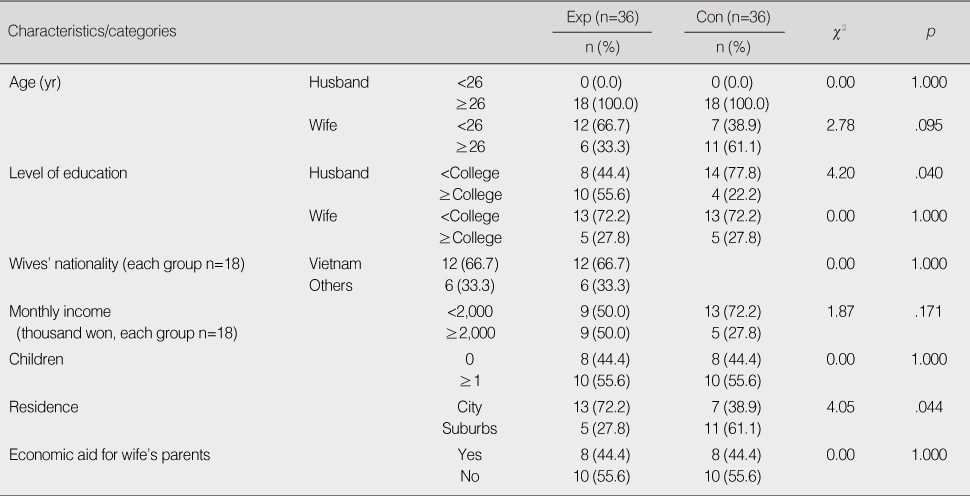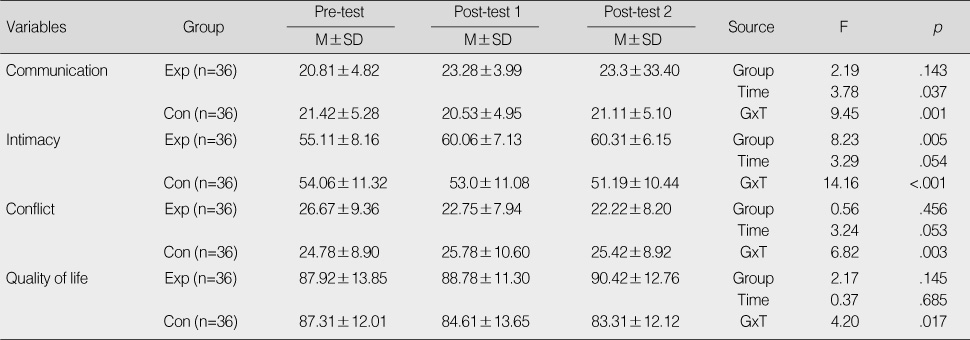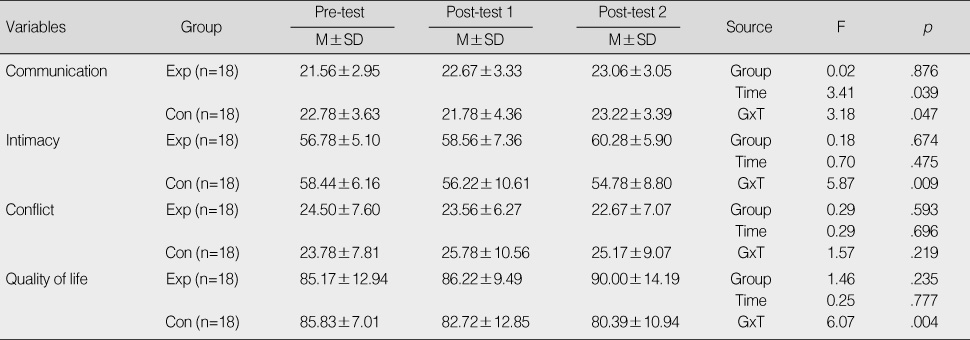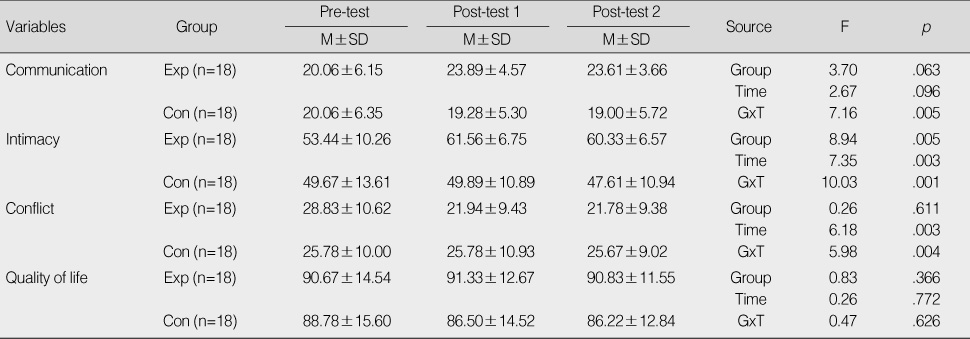Articles
- Page Path
- HOME > J Korean Acad Nurs > Volume 40(4); 2010 > Article
-
Original Article
- Effects on Couples' Communication, Intimacy, Conflict and Quality of Life by Foot Massage between Immigrants
- Dong-choon Uhm
-
Journal of Korean Academy of Nursing 2010;40(4):493-502.
DOI: https://doi.org/10.4040/jkan.2010.40.4.493
Published online: August 31, 2010
Assistant Professor, Department of Emergency Medical Technician, Daejeon University, Daejeon, Korea.
- Address reprint requests to: Uhm, Dong-choon. Department of Emergency Medical Technician, Daejeon University, 96-3 Yongun-dong, Dong-gu, Daejeon 300-716, Korea. Tel: 82-42-280-2941, Fax: 82-42-280-2946, dchuhm@dju.kr
Copyright © 2010 Korean Society of Nursing Science
Abstract
-
Purpose
- The purpose of this study was to evaluate the effects on immigrant couples' communication, intimacy, conflict and quality of life when using foot massage.
-
Methods
- The research design consisted of pre-and-post test consecutive experimental design through a nonequivalent control group. Data were collected July 6, 2009 to February 27, 2010. The 36 couples were divided into two groups, experimental and control with 18 couples in each group. Foot massage was applied twice a week for 6 weeks by the couples in the experimental group.
-
Results
- There were statistically significant increases in communication (p=.011), intimacy (p<.001), quality of life (p=.017) between the couples in the experimental group compared to the control group. There was also a statistically significant decrease in conflict (p=.003) between the couples in the experimental group compared to the control group.
-
Conclusion
- Foot massage can be applied as a nursing intervention for improvement of marital relationship in immigrant couples.
This work was supported by the National Research Foundation of Korea (NRF) grant funded by the Korea government (MEST) (No. 2009-0074725).
- 1. Byun WS, Lee MJ, Kim HY, Hwang JM, Lee SH. Domestic violence against marriage immigrants and support enhancement, 2008 Research Report-4. 2008;Seoul, Korean Women's Development Institute.
- 2. Chang SO. The conceptual structure of physical touch in caring. Journal of Advanced Nursing. 2001;33:820–827.ArticlePubMed
- 3. Cho YR. Marital conflicts, conflict coping behavior and marital satisfaction. 2000;Gwangju, Chonnam National University. Unpublished master's thesis.
- 4. Field T, Singer-Struck R, Cullen C, Hartshorn K. Improvements in the behavior of children with autism following massage therapy. Journal of Autism Developmental Disordered. 2001;31:513–516.
- 5. Han SY, Shin HC. Multi-group factor analysis and latent means analysis of the basic psychological needs importance scale for couples. Korean Journal of Counseling and Psychotherapy. 2007;19:447–465.
- 6. Hong DA, Chae OH. The values, communication type and conflict of international marriage couple. Korean Journal of Human Ecology. 2007;16:733–744.Article
- 7. Kammrath LK, Dweck C. Voicing conflict: Preferred conflict strategies among incremental and entity theorists. Personality and Social Psychology Bulletin. 2010;32:1497–1508.ArticlePDF
- 8. Kiecolt-Glaser JK, Robes TF. The physiology of marriage: Pathway to health. Physiology and Behavior. 2003;79:409–416.PubMed
- 9. Kim JS. A case study on interaction between autistic children and mothers through massage. 2007;Seoul, Sookmyung Women's University. Unpublished doctoral dissertation.
- 10. Kim ON. A study on the factors affecting marital conflicts of immigrant women. Family and Culture. 2006;18:63–106.
- 11. Kim ON, Kim KS, Lee JH. A study on improvement of marital relationship program for immigrant women's husbands. Journal of Korean Home Management Association. 2008;26(3):69–84.
- 12. Kong BH. Merleau-ponty's phenomenology of body and the experience of illness in nursing. Philosophy and Phenomenology Research. 2009;40:57–81.
- 13. Annual report on the causes of death statistics (1997-2007). Korea National Statistical Office. 2009;11;from http://www.kosis.kr/online/on00_index.jsp.
- 14. Kwak KH. A study on the effect of foot reflexology to the enrichment of marital intimacy on wive's perception. 2002;Daejeon, Hannam University. Unpublished master's thesis.
- 15. Lee KH. A measure of marital intimacy. Journal of the Korean Home Economics Association. 1995;33:235–249.
- 16. Min SK, Kim KI, Park IH. Korean version of WHO-QO. 2002;Seoul, Hana Medical Press.
- 17. Na SI, Jyung CY, Gu JO, Park HM, Chang HS, Kim JG, et al. Exploring action plan for the education innovation by types of rural areas for releasing education gaps between urban and rural areas. Journal of Agricultural Education and Human Resource Development. 2007;39:37–54.
- 18. Segrin C. Communication and the study of personal well-being. The International Journal for Communication Studies. 2005;67:547–549.ArticlePDF
- 19. Shin GH, Yang SE. Marital conflicts of international families in Korea. Journal of the Korean Home Economics Association. 2006;44(5):1–8.
- 20. Song BH. The effects of Korean and family life education for women in transnational marriages-focused on the Iksan transnational marriages and family support center program. 2008;Iksan, Wonkwang University. Unpublished master's thesis.
- 21. Uhm DC. Effects of foot reflexo-massage on physical, psychological, physiological parameters in patients with osteoarthritis. Journal of Korean Academy of Adult Nursing. 2004;16:276–287.
- 22. Woelz-Stirling N, Manderson L, Kelaher M, Gorden S. Marital conflict and finances among Filipians in Australia. International Journal of Intercultural Relations. 2000;24:791–805.Article
- 23. Yoon MH, Shin HC. Process model of marital intimacy on sharing daily events: Mediating effects of perceived partner responsiveness. Korean Journal of Social and Personality Psychology. 2009;23:17–23.Article
- 24. Youn H. Study on mental health of the Vietnamese female marriage migrants: Focused on urban-rural differences. 2009;Seoul, The Catholic University of Korea. Unpublished master's thesis.
REFERENCES
Figure & Data
REFERENCES
Citations

- Immigrant Vietnamese women’s adaptation to culture and society in rural areas of Korea
Misoon Jeon, Okhee Ahn, Minjeong An, Shang E. Ha
PLOS ONE.2019; 14(2): e0212265. CrossRef - Adaptation Experience to Family of Immigrant Women in Multicultural Families
Jin-Hyang Yang, Hyun-Joo Park, Song-Soon Kim, Eun-Jeong Kang, Sang-Hee Byun, Ji-Soo Bang
Journal of Korean Academy of Nursing.2012; 42(1): 36. CrossRef - Comparison of Marital Satisfaction and Quality of Life in International Married Woman Migrants and Korean Man
Yoon-Ji Park, Myunghee Jun
The Journal of Korean Academic Society of Nursing Education.2012; 18(3): 383. CrossRef - Effects of a Marital Relationship Enrichment Program on Communication, Conflict Resolution, and Marital Satisfaction in Multicultural Couples
Young-Ran Yeun, Soo Yang
Journal of Korean Academy of Psychiatric and Mental Health Nursing.2012; 21(3): 250. CrossRef - Adaptation Experience to Family of Immigrant Women in Multicultural Families
Jin-Hyang Yang, Hyun-Joo Park, Song-Soon Kim, Eun-Jeong Kang, Sang-Hee Byun, Ji-Soo Bang
Journal of Korean Academy of Nursing.2012; 42(1): 36. CrossRef
Homogeneity for General Characteristics between Groups (N=72)
Exp=Experimental group; Con=Control group.
Homogeneity for Dependent Variables (N=72)
Exp=Experimental group; Con=Control group.
Comparison of Communication, Intimacy, Conflict and Quality of Life between Groups (N=72)
Post-test 1: Post test at 3 weeks; Post-test 2: Post test at 6 weeks.
Exp=Experimental group; Con=Control group.
Comparison of Communication, Intimacy, Conflict and Quality of Life for Husbands (N=36)
Post-test 1: Post test at 3 weeks; Post-test 2: Post test at 6 weeks.
Exp=Experimental group; Con=Control group.
Comparison of Communication, Intimacy, Conflict and Quality of Life for Wives (N=36)
Post-test 1: Post test at 3 weeks; Post-test 2: Post test at 6 weeks.
Exp=Experimental group; Con=Control group.
Exp=Experimental group; Con=Control group.
Exp=Experimental group; Con=Control group.
Post-test 1: Post test at 3 weeks; Post-test 2: Post test at 6 weeks. Exp=Experimental group; Con=Control group.
Post-test 1: Post test at 3 weeks; Post-test 2: Post test at 6 weeks. Exp=Experimental group; Con=Control group.
Post-test 1: Post test at 3 weeks; Post-test 2: Post test at 6 weeks. Exp=Experimental group; Con=Control group.
 KSNS
KSNS
 E-SUBMISSION
E-SUBMISSION





 Cite
Cite

